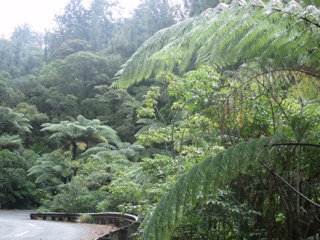Mangonui, a one time whaling port, has the most beautiful, tranquil bay and there was nothing better than having breakfast overlooking this sun drenched panorama. Over our coffee, we planned the day's route which seemed to intrigue other holidaymakers and they added their recommendations. We then input the route into the TomTom and set off, looking wistfully back over the bay, with its yachts and fishing boats bobbing peacefully on their moorings.
Striking inland, we followed the state highway (which really means a good road with one lane in each direction) for a few miles. The resplendent forest-topped hills and mountains with lush vegetation, rise steeply from river valleys and dominate the gorgeous panoramic views. Ian said that the terrain reminds him of the north of Scotland with the fir clad peaks and steep valleys in every direction.

Leaving the state highway, we meandered along the peninsular, drinking in the breathtaking views where sea touched land. Photographs just don't do it any justice. One thing that I cannot deny and that is New Zealand is one of the most beautiful countries I have visited
Our meandering brought us to Kerikeri, one of the first places to be settled by Europeans in the early 19th century. Here we found two of New Zealand's oldest buildings. The restored Kemp House, built as a mission house in 1822 and the Stone Store, originally built as a grain store for the mission house. The only way to see both buildings was to pay for the guided tour which we did. Our guide was extremely enthusiastic if not always accurate as she wove the tales of the two buildings. New Zealanders are fiercely proud of their history albeit only 200 years.
The main attraction to Kerikeri, however, is not historical but rather the arts and crafts with many outlets. The sand of time were running out for us and we weren't able to do justice to this town, but we did manage to stop at Wharepuke, the subtropical gardens, for afternoon tea.
We reset Mrs TomTom and pointed our nose across country to our final destination for the day, Opononi. Driving along State Highway 12 we were reminded of our drive through the Transkei in South Africa. All that was missing were the rondavaals, long drops and black pigs! Many of the villages that we passed through seem to be forgotten by time and progress.
Not surprisingly, the vegetation changed quickly from farmland to dense natural forest as we skirted the Northland Forest Park, traversed the foothills of the Tutamoe Range and dropped down to Opononi in the Hokianga Bay. The motel that we were staying in for the night was called the Opononi Lighthouse Motel and it transpired that the only lighthouse in Hokianga bay was the miniature at the front of the motel. Anyway, the room was clean and comfortable and the motel owners, Brent and Deborah were very friendly and helpful.
Hokianga an abbreviation for Hokianga nui a Kupe - the returning place of Kupe , was named after a Polynesian navigator, Kupe, said to be the founding father of Maori lore, legends and landscape-bearing names. I never did find out where he went and why he returned.
Friday 29th March
Heading south towards Auckland, we drove through the Waipoua forest, home to the kauri trees. The two largest kauri trees in New Zealand, Tane Mahuta (Lord of the Forest) and Te Matua Ngahere (Father of the Forest) are believed to be over 2000 years old. Tane Mahuta has a trunk girth of nearly 14m.
We stopped to admire these extraordinary trees and while we were taking photos, we noticed a lady scrabbling in the ground under the walkway. Triumphantly, she pulled out a plastic envelope and handed it to her husband. He saw us looking quizzically and them both and he introduced himself and his wife and told us their story. Bob and Adina are from Oregon USA. They told us of a friend and his wife who for many years had been living a parallel life to theirs. Apparently Bob went to the same school as the friend and Adina worked in the same hospital without ever meeting. Years later they met while on a hiking trip and after swapping stories discovered how their lives had followed similar paths. They also discovered that both couples had plans to visit New Zealand - at different times and when it was discovered that they intended to visit the same places, the friend set up a treasure hunt, leaving clues for Bob and Adina to follow. We saw Adina in the throws of unearthing a clue prize (snickers bar) at the big tree.
We continued driving through the Waipoua. Not only is it the home of the kauri trees but also the New Zealand national symbol, the silver fern tree.
The road wound through the forest and at one point even narrowed to a single lane so that the trees wouldn't be disturbed.
Leaving the forest behind, we stopped at Dargaville and spent a few fascinating hours at the museum. In there was a room devoted to the Kauri Gum and the Gum-diggers (the men who collected it). We had seen the tree, now we had a chance to learn about the Kauri Gum, the fossilised resin, sometimes known as New Zealand amber. In the 1800's kauri gum was used as a base for wood varnish and the resource was exploited but as the resource dwindled so did the Gum-diggers. Now the fossilised resin is mostly used for jewellery.
















































